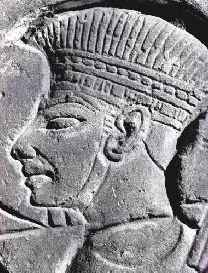Moving on to one of the bible's biggest propaganda stories we come to the discussion of David v Goliath.
To begin with, I will quote from the freakin' bible itself...hard to believe, I know.
4 And there went out a champion out of the camp of the Philistines, named Goliath, of Gath, whose height was six cubits and a span.
5 And he had an helmet of brass upon his head, and he was armed with a coat of mail; and the weight of the coat was five thousand shekels of brass.
6 And he had greaves of brass upon his legs, and a target of brass between his shoulders.
Now hold that thought while I review the purported time line. Around 1150 BC, Pharoah Ramesses III was able to defeat an invasion of Egypt by a group collectively known as the Sea People. This force had devastated most of the Eastern Mediterranean including the Hittites and Cyprus. Defeated by Ramesses III the principal group of the Sea People. known as the Peleset to the Egyptians landed in Southern Canaan and became known to history as the Philistines.
A century and a half later the bible claims that David pulled his great upset of Goliath.
However, as Finklestein points out, the bible story is an anachronism. It depicts Goliath dressed in chain mail, brass helmet and greaves.
Finklestein says:
Goliath's armor, as described in the bible, bears little resemblance to the military equipment of the early Philistines as archaeology has revealed it. Instead of wearing bronze helmets the Peleset shown on the walls of the mortuary temple of Ramesses III in Upper Eqypt wear distinctive feather-topped headdresses. Instead of being heavily armored and carrying a spear, javelin and sword, they use a single spear and do not wear the metal leg armor known as greaves. Yet the biblical description of Goliath's armor is not simply a fanciful creation; every single item has clear parallels to archaeologically attested Aegean weapons and armor from the Mycenean period to classical times. In all periods within this general time frame, once can find metal helmets, metal armor, and metal greaves. Yet, until the seventh century BC, these items were relatively rare in the Greek world. It is only with the appearance of the heavily armed Greek hoplites of the seventh through fifth centuries BC that standard equipment comes to resemble Goliath's. In fact, the standard hoplite's accouterments were identical to Goliath's, consisting of a metal helmet, plate armor, metal greaves, two spears, a sword and a large shield. And this suggests that the author of the biblical story8 of David and Goliath had an intimate knowledge of Greek hoplites of the late seventh century BC.
Moreover, the Greek historian Herodotus reports that Greek mercenaries from Asia Minor were serving the Egyptians in the reign of the Pharoah Psammetichus I who took over the Philistine coastal areas just at the time that the state of Judea was pulling itself together into something resembling a full-blown state. The clear analogy is that "David" is put into the role of the personification of Judah facing off with the newly restored Egyptian military might....which probably included Philistine vassals but almost certainly included Greek mercenaries which were the panzer divisions of their age.
All of which means, therefore, that the pious biblical scriptures are a concocted story pitting a 10th century David against a warrior of a type which did not exist for another 2 centuries.
Consider the bible description above with these images of Greek hoplites.


as opposed to the archaeologically discovered images of Philistine warriors such as this:

Something is wrong here. War, disease, death, destruction, hunger, filth, poverty, torture, crime, corruption, and the Ice Capades. Something is definitely wrong. This is not good work. If this is the best God can do, I am not impressed.
-- George Carlin




